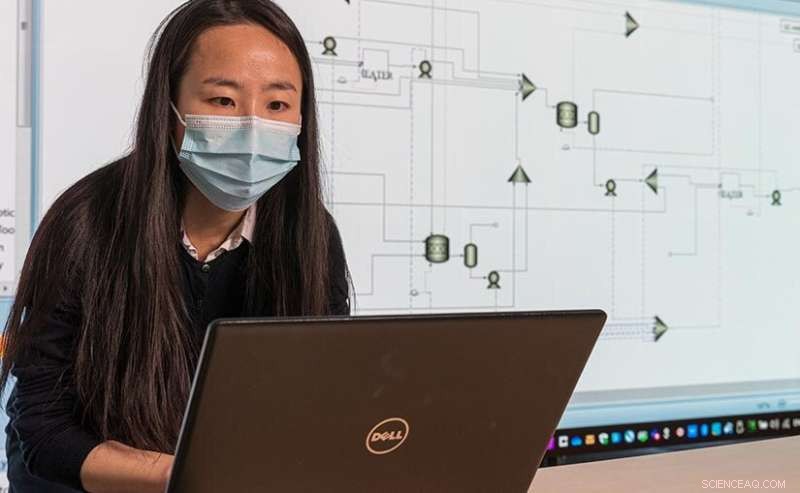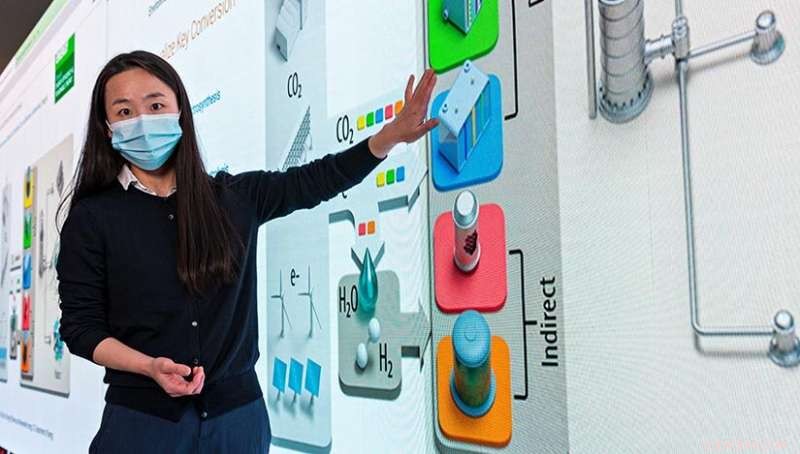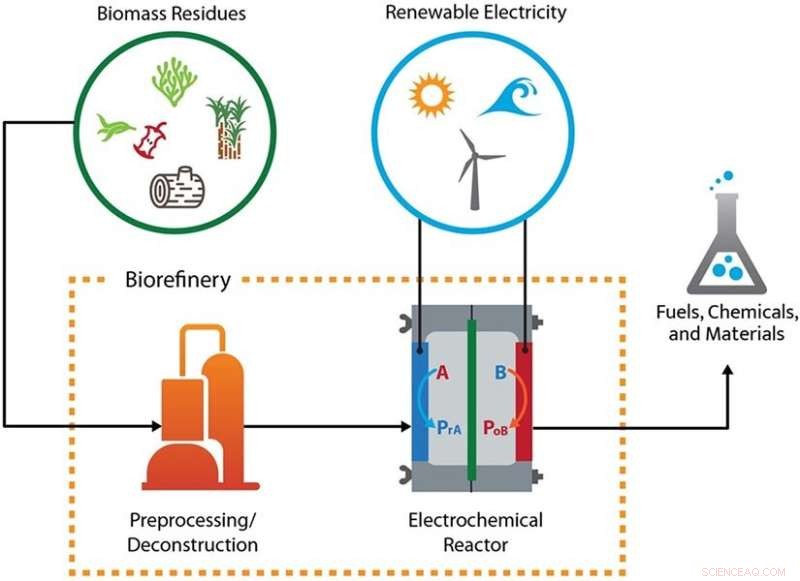
Découvrir les coûts, les risques et les opportunités - Les chercheurs du NREL, dont le scientifique Zhe Huang (photo), analysent le potentiel technique et économique de l'électrification et de la décarbonisation de la production de carburant et de produits chimiques. Crédit :Werner Slocum, NREL
Le pétrole, le charbon et le gaz naturel ne sont pas les seuls points de départ pour fabriquer des carburants et des produits chimiques. En fait, les approvisionnements croissants en électricité renouvelable ouvrent de nouvelles portes passionnantes pour fabriquer des produits identiques à potentiellement une fraction du coût climatique.
Cela commence par le tour régulier d'une éolienne ou d'un panneau solaire qui chauffe sous le soleil de l'après-midi. Un courant traverse une cellule électrochimique remplie de dioxyde de carbone (CO2 ) :siphonné dans l'air ou récupéré dans une raffinerie d'éthanol, une cimenterie ou une autre source industrielle.
Dynamisé par les ions et les radicaux créés par la charge, l'atome de carbone du gaz se décolle de ses voisins oxygène et cherche de nouveaux compagnons avec lesquels se lier. Il se verrouille rapidement sur d'autres carbones nouvellement libérés, ainsi que sur des atomes d'hydrogène générés dans la cellule.
La molécule exacte que le carbone aide à former dépend de l'électrocatalyseur dans la cellule et de la tension appliquée au départ :
Il s'agit d'une réaction électrochimique, une voie émergente pour valoriser le CO2 et même des composés dérivés de la biomasse dans les nombreux plastiques, détergents, carburants et composés qui sous-tendent l'économie moderne.
Parallèlement à un ensemble plus large de technologies qui utilisent de l'électricité renouvelable pour synthétiser des produits chimiques et des carburants, la technologie est prometteuse pour aider à décarboner l'industrie lourde. Mais sont-ils vraiment prêts pour le marché ?
Sur les coûts, les risques et les opportunités de l'électrification de la production de produits chimiques et de carburants
"Essentiellement, nous parlons d'une intersection de l'électrification et de l'utilisation de matières premières à faible émission de carbone comme le dioxyde de carbone et la biomasse", a déclaré Joshua Schaidle, responsable du programme de laboratoire du National Renewable Energy Laboratory (NREL) pour l'Office of Fossil Energy and Fossil Energy du Département américain de l'énergie. Gestion du carbone. Schaidle dirige également la recherche sur la transformation catalytique du carbone du NREL et dirige le consortium de catalyse chimique pour la bioénergie du département américain de l'énergie. "Alimentés par des énergies renouvelables au lieu d'électricité fossile, ces systèmes pourraient permettre aux industries d'aller au-delà du carbone fossile."
Selon Schaidle et son collègue du NREL, Gary Grim, cette méthode alternative de fabrication de carburants et de produits chimiques pourrait être un outil essentiel pour décarboner un secteur économique qui laisse souvent de profondes empreintes carbone dans son sillage.
Au lieu de draguer le carbone "fossile" stocké sous terre, ces méthodes recyclent le carbone "moderne" présent dans le CO2 ou biomasse. Et plutôt que de dépendre de sources d'énergie à forte intensité de carbone, ils sont alimentés par de l'électricité renouvelable à zéro émission. Le résultat pourrait être un processus de production de carburant et de produits chimiques beaucoup moins intensif en carbone.
Pourtant, de nombreuses questions subsistent sur les coûts, les risques et les défis techniques liés à la fabrication de produits chimiques et de carburants à partir d'électricité verte et de carbone recyclé. « Où en sont les technologies aujourd'hui ? Où pourraient-elles être à l'avenir ? Et comment cela joue-t-il un rôle dans les prochaines étapes et les futurs besoins de recherche ? » demanda Schaidle.
Dans une paire d'articles publiés dans Energy and Environmental Science et Lettres énergétiques ACS, Schaidle, Grim et leurs collègues explorent ces questions et d'autres sur le potentiel technique et économique de l'électrification et de la décarbonisation de la production de carburant et de produits chimiques.
Avec beaucoup d'incertitudes, ils espèrent qu'un tel travail pourra aider à tracer la voie à suivre entre la paillasse de laboratoire et le monde commercial.
Document 1 :L'économie de l'utilisation du dioxyde de carbone
Des études suggèrent que des technologies existent aujourd'hui pour convertir le CO2 dans tous les produits chimiques et produits à base de carbone les plus consommés dans le monde, un marché actuellement dominé par les sources fossiles de carbone.

Grâce à un outil de visualisation en ligne, NREL offre un aperçu de la faisabilité économique et des principaux facteurs de coût de la production d'intermédiaires chimiques à partir de CO2 et d'électricité à travers cinq voies de conversion différentes. Il s'agit notamment des voies qui utilisent directement l'électricité renouvelable pour transformer chimiquement le CO2 en produits chimiques, ainsi que des voies qui utilisent l'électricité indirectement via des transporteurs d'électrons intermédiaires, tels que l'hydrogène. Crédit :Werner Slocum, NREL
Par exemple, chaque année, plus de 10 gigatonnes de carbone sont émises sous forme de CO2 autour du monde. S'il est capturé et envoyé à travers une cellule électrochimique à la place, ce CO2 peut devenir une source d'approvisionnement suffisante pour produire plus de 40 fois la totalité de la production mondiale d'éthylène et de propylène.
Dans une filière Sciences énergétiques et environnementales article, "Les perspectives économiques de la conversion du CO2 and Electrons to Molecules", les chercheurs du NREL Zhe Huang, Schaidle, Grim et Ling Tao analysent l'économie du CO électrochimique2 utilisation aujourd'hui et à l'avenir. Le document examine de nombreux facteurs technologiques et facteurs de coût susceptibles d'avoir une incidence sur la faisabilité de la production de produits chimiques, de carburants et de matériaux à partir de CO2 et l'électricité renouvelable à grande échelle.
"Nous examinons de manière large plusieurs technologies pour plusieurs produits", a déclaré Grim. "Le point clé est que nous utilisons des hypothèses économiques cohérentes pour notre analyse."
Selon leur étude, il pourrait bientôt être aussi rentable de fabriquer certains des produits chimiques les plus largement utilisés à partir de CO2 and green electricity as it is to make them using current petroleum-based methods. At the current rate of falling electricity prices and expected improvements in technology, it could even become cheaper in some cases.
"The advancements we are seeing, the activity we are seeing—we will have commercial offerings in the next 5 to 10 years," Schaidle said. "I think there are opportunities to get down to cost competitiveness, especially as you start to consider any low-carbon credits that come along."
To arrive at such conclusions, the study incorporates a broad range of assumptions. It considers energy prices and the cost to build new facilities or install new equipment. It factors in technical and chemical influences that could impact the viability of a technology, such as the speed or efficiency of a certain electrochemical reaction.
Not least, the analysis takes a close look at the impact of CO2 source and concentration on the price to make a given chemical, be it carbon monoxide, ethylene, or a hydrocarbon fuel. Where CO2 siphoned directly from the atmosphere is relatively dilute, for example, capturing it from a power plant or biorefinery yields higher concentrations.
To make it easier to sift through the data behind their analysis, Schaidle, Grim, and their colleagues have published a powerful online visualization tool. It includes interactive charts on the economic feasibility and key cost drivers of producing chemical intermediates from CO2 and electricity across five different conversion pathways.
In this way, the takeaways from the paper become easily accessible for a broad audience. For example, their analysis concludes that carbon monoxide made from CO2 and electricity via high-temperature electrolysis—a specific kind of electrochemical technology—would be relatively expensive by today's standards, at $0.38 per kilogram. Move into the near future, however, and the economics flip. The study projects the price to fall well below today's market price to $0.15 per kilogram.
"Is this a reality? How close can we get on a cost-competitive basis?" reflected Schaidle. "What are the performers or non-performers?"
With the new paper and visualization tool, arriving at answers is easier than ever before.
Paper 2:The status of electrochemical conversion of plentiful biomass
According to the U.S. Department of Energy, biomass resources in the United States could be harnessed to produce up to 50 billion gallons of biofuel each year, more than enough to cover the entire U.S. demand for jet fuel.
But where the carbon in CO2 forms a simple chemical configuration—a gas with one part carbon, two parts oxygen—the renewable carbon in that plentiful biomass is integrated into fibrous networks of lignin and carbohydrates. That makes the starting point for making chemicals with biomass fundamentally different.
Biomass—which includes energy crops, forestry waste, and other organic matter—must first be broken apart into chemical intermediates:polyols, furans, carboxylic acids, amino acids, lignin, and others. Once stored in a more basic form, that renewable carbon can then be more easily accessed, amended, and rearranged.
"You can convert these intermediate molecules thermochemically and biologically, but you can also look at electrochemistry," Schaidle explained. "Our review focuses on the latter piece, where you are looking at converting an intermediate into a product rather than starting with whole biomass."

A large number of fuels, chemicals, and materials can be accessed from biomass using renewable electricity. In the electrochemical reactor, “A” and “B” represent biomass-derived compounds that are upgraded by forming either reduction products (blue arrow, PrA) or oxidation products (red arrow, PoB). Credit:National Renewable Energy Laboratory
In a second paper published in ACS Energy Letters , Schaidle, Grim, and a larger team of scientists—including Francisco W.S. Lucas and Adam Holewinski from the University of Colorado, Boulder—analyze over 82 reactions driven by the electrochemical synthesis of biomass intermediates. Those reactions have potential advantages, according to the paper.
"Conventional methods only have heat and pressure as their hammers," Grim explained. "With electrochemistry and biomass intermediates, we have the ability to target specific chemical bonds or groups that can be otherwise difficult to access."
Grim said that could give industries more latitude to invent chemistries otherwise hard to achieve—a potential advantage over conventional, petroleum-based refining. Still, the electrochemical synthesis of biomass intermediates is immature compared to CO2 utilization.
"If you want this technology to get closer to becoming market competitive, you have to have an electrochemical process that is overall more efficient," Schaidle added. "It makes the best utilization of the carbon coming in and the best utilization of the electrons coming in. That is where a lot of the technology advancements need to happen."
By pulling together more than 500 publications on the field—articles often focused on specific reactions using electrochemistry—the paper serves as a roadmap for assessing the state of electrochemistry with biomass-derived intermediates and finding the best entry points for improving the technology. With this broad analysis, the team of scientists aims to foster more focus and intentionality in future research.
"This is cross-cutting analysis to help people move forward," Schaidle added. "We are synthesizing all the science to give a clear blueprint for strategic research."
Slow but steady:Steps to decarbonizing chemical manufacturing
Schaidle and Grim are honest about the challenges ahead. After all, should we even try to electrify biomass conversion? Why convert CO2 and not just capture it and put it underground?
"The short answer is that there are a lot of challenges," Grim said. "Petroleum- and fossil-based processes have had nearly a century head-start on some of these emerging technologies. Those systems are highly optimized, very well studied—and hydrocarbons have a lot of energy already built in."
With no energy content whatsoever, CO2 must be pumped with massive amounts of cheap, clean energy to successfully transform it into something usable. Many electrochemical technologies for converting biomass intermediates have yet to be scaled beyond the lab—an essential step for demonstrating the stability, efficiency, and affordability of any bioenergy technology. Not least, robust supply chains of renewable electrons, CO2 , and biomass are only just emerging.
"The jury is still out:Is this the best use of that abundant future electricity?" Grim asked. "We are still working to understand if these technologies are the best solution for addressing a lot of our climate issues."
Despite the challenges, Schaidle and Grim remain optimistic that these technologies can play a critical role in decarbonizing fuel and chemical manufacturing.
Supported by the U.S. Department of Energy Bioenergy Technologies Office, ARPA-E, and other energy programs, a range of targeted research projects are already helping push down the cost and increase the efficacy of such technologies. One NREL-led team, for instance, is exploring how to use electrochemistry to enable biorefineries to recycle waste CO2 —increasing fuel yields by as much as 40% and decarbonizing the production of ethanol, as well as lipids.
With a nudge in the right direction, more breakthrough projects could be on the horizon.
"How do we guide this field to collectively accelerate everyone's work?" Schaidle said. "That's what we wanted to do—to take this blob of an amoeba and turn it into a foundational first step for people to build off of."
By gathering all the available data—standardizing it, making it comprehensible, giving it form—they hope they can collapse the timeline for improving the technologies. And with deadlines looming for making meaningful progress to lower climate-warming emissions, accelerating R&D could be just what is needed to start eliminating the weighty carbon footprint of making fuels and chemicals.